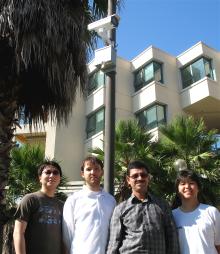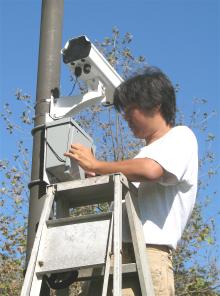

B. S. Manjunath came up with the idea for his latest research project during a faculty meeting a few years ago. The UC Santa Barbara professor of electrical & computer engineering spotted a science magazine with a cover photo of birds taking flight on a beach.
"It was about a project in Italy where they were monitoring birds," Manjunath said. "There were trying to capture them with high-speed video cameras, to estimate their 3D position, to track them, to try to understand how they fly. I thought, ‘This looks cool.' If I had a network of cameras, I could do that."
Thanks to a federal grant, Manjunath's vision of a comprehensive camera network on the UCSB campus is about to become a reality. A team of researchers led by Manjunath and three of his graduate students are coordinating installation of the cameras at various locations around campus. The array of cameras will include ethernet-linked cameras inside Harold Frank Hall; battery-powered cameras mounted above campus bicycle paths, Kirby Crossing, and Steck Circle near the east entrance to campus; and solar-powered cameras at Coal Oil Point Reserve.
Manjunath and other researchers have a variety of goals for the project, including documenting patterns of human movement, both inside buildings and on bicycle paths, as well as monitoring the nesting areas of snowy plovers on the beaches near campus. But there is one thing he would like to emphasize: The video network will not be used for surveillance. "I think the best thing in a project like this is to be very transparent," he said. "There are some people who might be concerned about something like this. The cameras are not operational 24/7. We're not interested in what individuals are doing, but in the collective behavior to understand the human spatial dynamics."
Cameras have been up in Harold Frank Hall for several months, most of them in the hallways of all five floors, though no data collection has started.
What the researchers are interested in are the patterns of movement within the building, with people going in and out during the day. "Would it be possible for us to say that during the day, 10 percent of the people entered the building through the west entrance and went to the fifth floor, and 20 percent went to the third floor, and 10 percent came from the back door? We want to develop novel computer vision algorithms that can make use of such a distributed sensor network for a variety of applications." Other faculty members are interested in patterns of movement on the bicycle paths, or developing models for energy efficiency, or developing distributed control algorithms. "There are many different applications, and different groups have different research interests," Manjunath said.
The project's Web site will post times when data will be gathered. The video will only be collected for 45 minutes to an hour at a time, and usually only three or four times per week for experiments. The total amount of video data may not exceed 5-10 hours per camera during the project period. Images will not be distributed without prior approvals, he said. "All the video data will be processed to remove any personal identification information, such as blurring faces if they are visible," Manjunath said. "It has taken almost 18 months since the beginning of the project to go through various campus committees for approvals, including the human subjects committee and the police department."
After funding, Manjunath contacted Cristina Sandoval, director of the Coal Oil Point Reserve, and asked if she would be interested in participating. Sandoval immediately said yes.
"The camera network will be an efficient method for collecting data that is otherwise too time-consuming or potentially biased because of an observer's presence," Sandoval said. "Researchers will be able to record the visitations of pollinators to flowers and monitor if climate change will modify the pollinator-flower interactions. We will also be able to monitor the behavioral response of nesting plovers to approaching predators, people, or any other type of disturbance, such as fireworks."
In addition, some of the cameras will monitor the shoreline, which Sandoval hopes will allow researchers to judge the impact of an expected rise in sea level over the next decade.
Manjunath estimates that it will take another three to six months to get all cameras in place and the network connected. And he anticipates that the data for this particular study will be gathered for 18 months. The project is funded for two years. The plan is to remove the cameras on campus after the project ends. At Coal Oil Point, the infrastructure will be handed over to reserve officials to continue their research.
Joining Manjunath in this research project, funded by the Defense University Research Instrumentation Program, are faculty members João Hespanha, Upamanyu Madhow, and Ken Rose, of electrical and computer engineering; Tobias Hollerer, Chandra Krintz, Kevin Almeroth, Ambuj Singh, and Matthew Turk, of computer science; and Francesco Bullo of mechanical engineering.
† Top photo: Standing under a camera installed outside Harold Frank Hall are, from left, Zefeng Ni, Carter De Leo, B.S. Manjunath, and Thomas Kuo. Manjunath is a professor of electrical and computer engineering, while Ni, De Leo, and Kuo are graduate students.
Photos by George Foulsham UCSB Office of Public Affairs
†† Bottom photo: Graduate student Thomas Kuo finishes the installation of a camera outside Harold Frank Hall.
Photos by George Foulsham UCSB Office of Public Affairs



